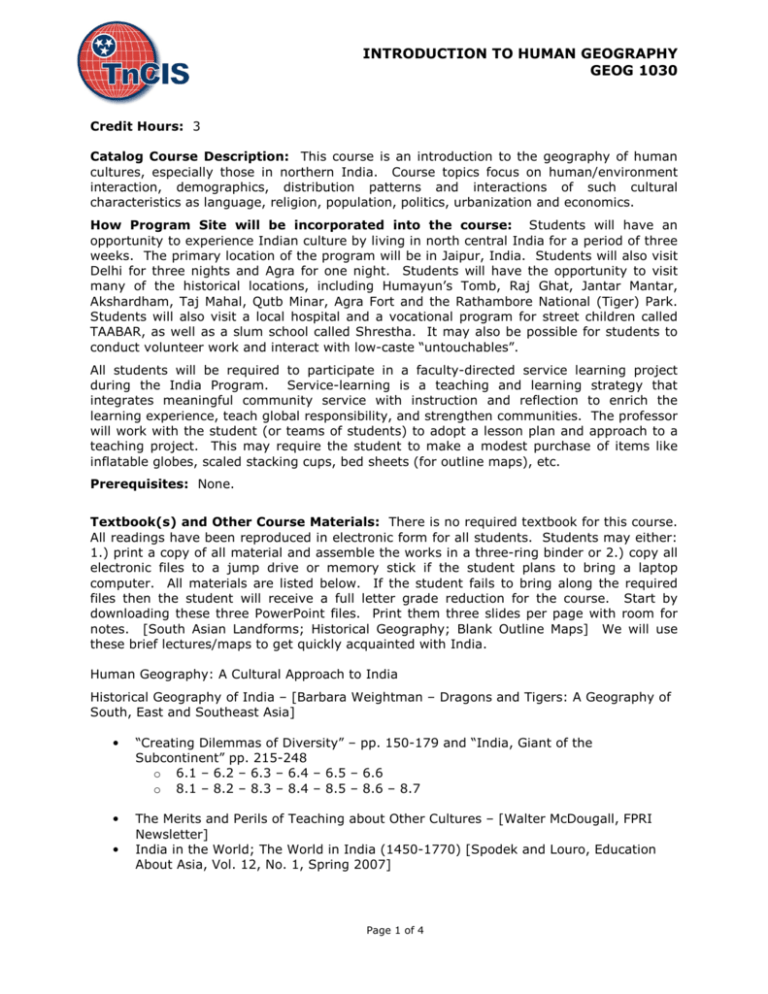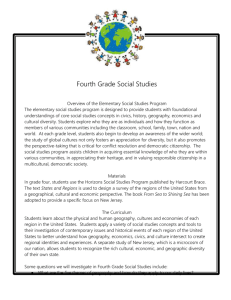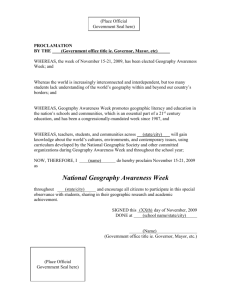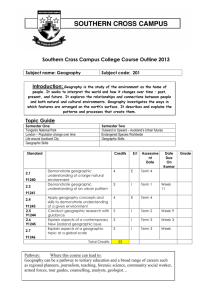INTRODUCTION TO HUMAN GEOGRAPHY GEOG 1030
advertisement

INTRODUCTION TO HUMAN GEOGRAPHY GEOG 1030 Credit Hours: 3 Catalog Course Description: This course is an introduction to the geography of human cultures, especially those in northern India. Course topics focus on human/environment interaction, demographics, distribution patterns and interactions of such cultural characteristics as language, religion, population, politics, urbanization and economics. How Program Site will be incorporated into the course: Students will have an opportunity to experience Indian culture by living in north central India for a period of three weeks. The primary location of the program will be in Jaipur, India. Students will also visit Delhi for three nights and Agra for one night. Students will have the opportunity to visit many of the historical locations, including Humayun’s Tomb, Raj Ghat, Jantar Mantar, Akshardham, Taj Mahal, Qutb Minar, Agra Fort and the Rathambore National (Tiger) Park. Students will also visit a local hospital and a vocational program for street children called TAABAR, as well as a slum school called Shrestha. It may also be possible for students to conduct volunteer work and interact with low-caste “untouchables”. All students will be required to participate in a faculty-directed service learning project during the India Program. Service-learning is a teaching and learning strategy that integrates meaningful community service with instruction and reflection to enrich the learning experience, teach global responsibility, and strengthen communities. The professor will work with the student (or teams of students) to adopt a lesson plan and approach to a teaching project. This may require the student to make a modest purchase of items like inflatable globes, scaled stacking cups, bed sheets (for outline maps), etc. Prerequisites: None. Textbook(s) and Other Course Materials: There is no required textbook for this course. All readings have been reproduced in electronic form for all students. Students may either: 1.) print a copy of all material and assemble the works in a three-ring binder or 2.) copy all electronic files to a jump drive or memory stick if the student plans to bring a laptop computer. All materials are listed below. If the student fails to bring along the required files then the student will receive a full letter grade reduction for the course. Start by downloading these three PowerPoint files. Print them three slides per page with room for notes. [South Asian Landforms; Historical Geography; Blank Outline Maps] We will use these brief lectures/maps to get quickly acquainted with India. Human Geography: A Cultural Approach to India Historical Geography of India – [Barbara Weightman – Dragons and Tigers: A Geography of South, East and Southeast Asia] • “Creating Dilemmas of Diversity” – pp. 150-179 and “India, Giant of the Subcontinent” pp. 215-248 o 6.1 – 6.2 – 6.3 – 6.4 – 6.5 – 6.6 o 8.1 – 8.2 – 8.3 – 8.4 – 8.5 – 8.6 – 8.7 • The Merits and Perils of Teaching about Other Cultures – [Walter McDougall, FPRI Newsletter] India in the World; The World in India (1450-1770) [Spodek and Louro, Education About Asia, Vol. 12, No. 1, Spring 2007] • Page 1 of 4 Population Geography: An Imbalance of Epic Proportions • • • • Population Seven Billion [Robert Kunzig, National Geographic Magazine, January 2011] Indians Go Home, But Don’t Leave U.S. Behind [New York Times] All Roads Lead to Cities, Transforming India [New York Times] Building population (age-sex) pyramids: India, Japan and Niger [Handout w/graphing paper] Nature and Society • • • • The Bishnoi: An Ecotheological Community in the India Desert [Pankaj Jain, Journal of Vaishnava Studies, 2010] A Harvest of Water – [Sara Corbett, National Geographic Magazine, November 2009] India Digs Deeper, But Wells are Drying Up [New York Times] How to Save the Taj Mahal? [Jeffrey Bartholet, Smithsonian Magazine] Geographies of Race and Ethnicity: Garden Salad or Melting Pot? • • Untouchable (O’Neill) [National Geographic Magazine, June 2003] Emancipating Twenty-First-Century Slaves (Part 1 & Part 2) [Kristof & WuDunn, Half the Sky] Political Geography: A Divided World • • • • The View From Delhi (Part 1 & Part 2) – [Robert Kaplan, Monsoon: The Indian Ocean and the Future of American Power] India’s Democracy: Illusion or Reality? [Philip Oldenburg] Partition – [W.H. Auden, poem] Salt and the Great Soul – [Mark Kurlansky, Salt: A World History] Culture and Religion: Spaces and Places of Sacredness • • • The Blind Men and the Elephant – [John G. Saxe, poem] Death and Dying [Hinduism Today] Too Young to Wed – [Cynthia Gorney, National Geographic Magazine, June 2011] Economic Geography: Agriculture, Industries, Services, and Development • • • • Lost Nomads – [John Lancaster, National Geographic, February 2010] Welcome to Bollywood – [Suketu Mehta, National Geographic Magazine, February 2005] Fast Lane to the Future – [Don Belt, National Geographic, October 2008] Road Rage in India – [Nirmala George, Associated Press] India’s Pool Reel Under Microfinance Debt Burden [Cory Flintoff, National Public Radio] • Galloping Growth, and Hunger in India [Vikas Bajaj, New York Times] Urbanization: The City in Time and Space [See graphic below.] Future Geographies: http://delhi-masterplan.com/zonal-plans-mpd-2021/land-useplan.php I. Week/Unit/Topic Basis: WEEK # TOPIC Week 1: Delhi and Agra Geography Basics; Introduction to India Through Cultural Geography; Population Geography Week 2: Jaipur Nature and Society; Geographies of Race and Ethnicity; Political Geography Week 3: (back to Delhi) Culture and Religion; Economic Geography; Urbanization Page 2 of 4 II. Course Objectives*: The primary educational objective of this course is to provide information that enables the student to understand the various human culture groups of the world, and specifically those in India. It seeks to identify their geographical boundaries and interactions with their local environment (i.e. physical characteristics, natural resources, climate, cultural differences with neighboring ethnic peoples and related problems, etc.). Outcomes are summarized as follows: A. Recognize, describe, and explain social institutions, structures, and processes and the complexities of a global culture and diverse society ["Social Science" Outcome #1] B. Analyze and compare political, geographic, economic, social, cultural, religious and intellectual institutions, structures, and processes across a range of historical periods and cultures ["History" Outcome #2] C. Think critically about how individuals are influenced by political, geographic, economic, cultural, and family institutions in their own and other diverse cultures and explain how one's own belief system may differe from others. ["Social Science" Outcome #2] D. Recognize and articulate the diversity of human experience across a range of historical periods and the complexities of a global culture and society ["History" Outcome #3] E. Analyze the contributions of past cultures/societies to the contemporary world ["History" Outcome #5] *Numerals after course objectives reference TBR’s general education goals. III. Instructional Processes*: Students will: A. Explain geographic patterns, processes and future trends and apply them to specific content B. Apply maps, graphs and statistics, photographs and fieldwork to analyze and integrate data in geographical contexts C. Evaluate geographical information and sources for usefulness, validity and reliability D. Plan geographical inquiries to analyse and synthesize information from a variety of sources E. Communicate complex geographical information, ideas and issues effectively, using appropriate written and/or oral, cartographic and graphic forms IV. Expectations for Student Performance* Upon successful completion of this course, the student should be able to: A. Understand the basics of geography, specifically cultural geography. B. Comprehend the unique cultural setting of India, as well as the greater pattern of culture(s) around the globe. C. Understand the dynamics of global population growth and decline, specifically the excessively high population growth rate in India, as well as the disparity of the male/female ratio. D. Illustrate the role environment plays in developing culture, as well as the human impact on nature. Page 3 of 4 E. Understand the collision of cultures across the globe, and more specifically in India (e.g. Hindu vs. Muslim vs. Sikh, class warfare, untouchables, gender inequity, etc.). F. Understand the levels of economic development and the interaction of economies across the globe. G. Understand the politics of space (as India is the largest democracy in the world). V. Evaluation: A. Testing Procedures: Prepared exam questions in the form of multiple choice or matching, coupled with intermediate or long response questions. B. Laboratory Expectations: N/A C. Research Paper: N/A D. Other Evaluation Methods: Mapping assignment (physical, political and culture regions); graphing raw population data into age-sex pyramids; daily journal responses that integrate field observations with directed readings E. Grading Scale: Please note that some TnCIS member institutions do not accept + and - grades, therefore all TnCIS grading scales must consist of only A, B, C, D, F letter grades. A = 90 - 100 B = 80 – 89 C = 70 – 79 D = 60 – 69 F = Below 60 VI. Policies: A. Attendance Policy: Attendance is of utmost importance in study abroad courses. There are no unexcused absences permitted. Unexcused absences are grounds for removal from the program. Being in class on time is also very important. Frequent tardiness will be considered an absence and appropriate action will be taken. Absences due to illness must be reported immediately to the program director. B. Academic Dishonesty: Academic misconduct committed either directly or indirectly by an individual or group is subject to disciplinary action. Prohibited activities include but are not limited to the following practices: Cheating, including but not limited to unauthorized assistance from material, people, or devices when taking a test, quiz, or examination; writing papers or reports; solving problems; or completing academic assignments. In addition to other possible disciplinary sanctions that may be imposed as a result of academic misconduct, the instructor has the authority to assign either (1) an F or zero for the assignment or (2) an F for the course. VII. Instructional Hours: Instructional time spent in a formal classroom setting and during excursions will total a minimum of 37.5 hours for this course. Page 4 of 4






